the nature museum, rockbuand art museum. shanghai
All images by the ICZ
selected works
Download PDF English Guide here.
Download PDF Chinese Guide here.
Introduction
The Institute of Critical Zoologists
The Institute of Critical Zoologists (ICZ) aims to reconfigure the ways in which natural history and ecological research findings are presented and experienced, taking the natural sciences beyond the confines of the laboratory and research circles.
ICZ is run by a collective of professional scientists, historians, writers, anthropologists and artists. Its work straddles a myriad forms: research publication, conferences, installation art, photography, exhibitions and performance. The Institute employs a range of methodologies — from anthropological inquiry to image-making — to create new ways of understanding natural phenomena.
This exhibition focuses on the ways communities have interacted with nature in different time periods and geographical regions. In tracking these encounters and their histories, from colonial knowledge-production to contemporary urban ecology, this show unites multiple strands of knowledge into a single museological encounter: Employing the Institute’s full range of investigative methodologies, the artefacts on display include archival images and historical texts, research papers, documentary photography and installation.

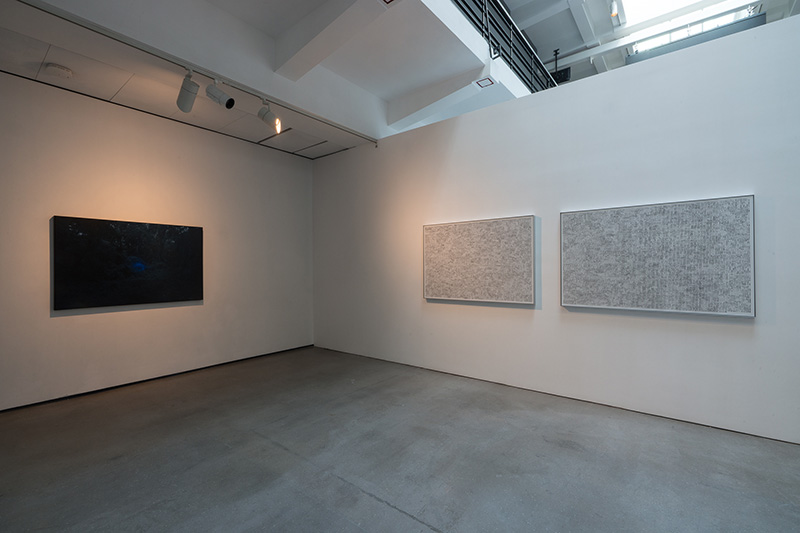
Bee Trap, 2013
150cm x 100cm, archival pigment print face mounted on plexiglass, aluminium frame
Bees favour the colour blue so much that they stay put once they settle in an area of that colour. A very simple bee trap that entomologists developed was made by simply painting an area of the forest blue.
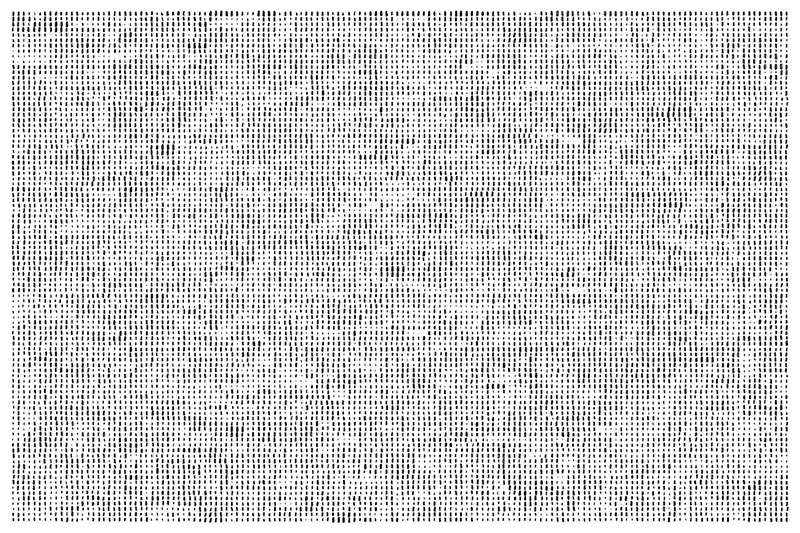

Trying to Remember a Tree, 2016
150cm x 100cm each, diptych, archival pigment print face mounted on plexiglass, aluminium frame
Since 2013, ICZ has been documenting all the raintrees in Singapore. In 2015, a young raintree in Orchard was felled to make way for development. The Institute set out to document as much of it as possible by relocating the foliage back to the studio. To document the full scale of the tree without reconstructing it, ICZ photographed each of its 28,017 leaves. The process took one year.

He counts the stars and call them all by name
210cm x 150m, archival pigment print face mounted on plexiglass, aluminium frame
A photograph showing 4,784 flies from a single family of flies, the hoverfly. Each fly is labelled with information of its provenance and some of these flies mimic other insects like bees and wasps to cheat predators.
The flies are collected by an entomologist, Martin Hauser, who works for the US Department of Agriculture. His job is to spot potentially invasive insects hiding in crops from coming through Californian border. Dogs are stationed at the borders to sniff out even the eggs of insects in incoming produce. When the border patrol spots an insect, a photograph is taken and sent over to Martin. Martin then has to decide if the insect is safe to pass the border.
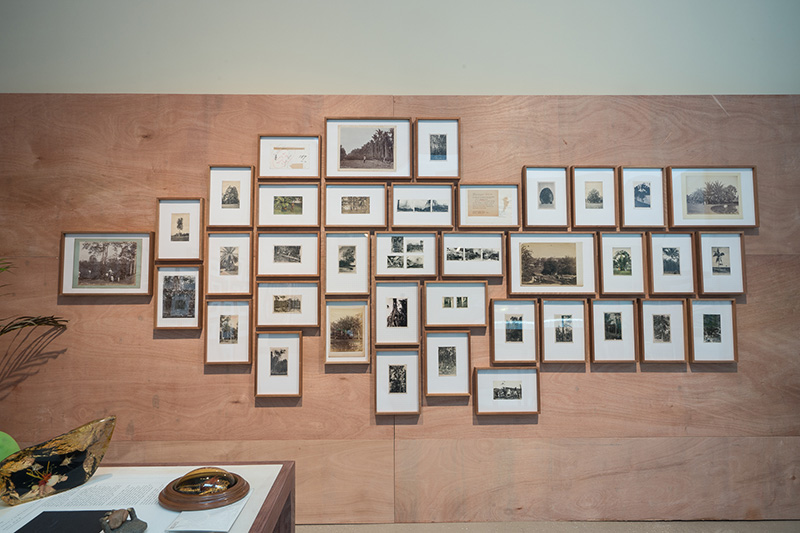
The Great British Empire Exhibition, Malaya Pavilion, Forestry Hall
Installation of found photography, dimensions variable
2011-ongoing
Fifty-six out of the 58 colonies took part in the British Empire Exhibition held at Wembley Park, London in 1924 and 1925. The exhibition showcased agricultural discoveries and zoological specimens collected from the various territories.
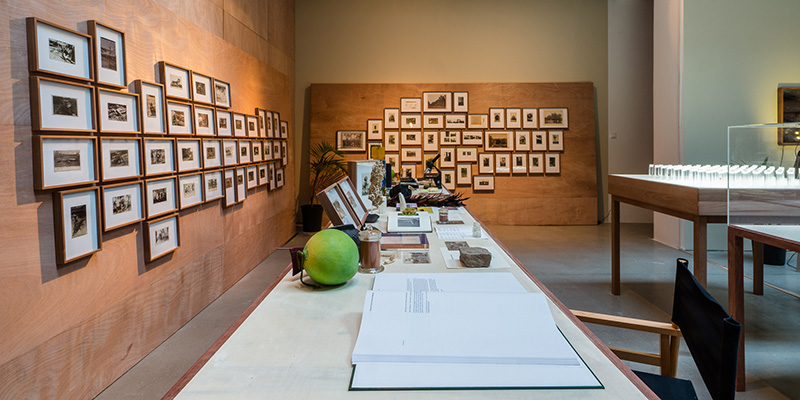
The Great British Empire Exhibition, Malaya Pavilion, Animals at the fair (Left Wall)
Installation of found photography, dimensions variable
2011-ongoing
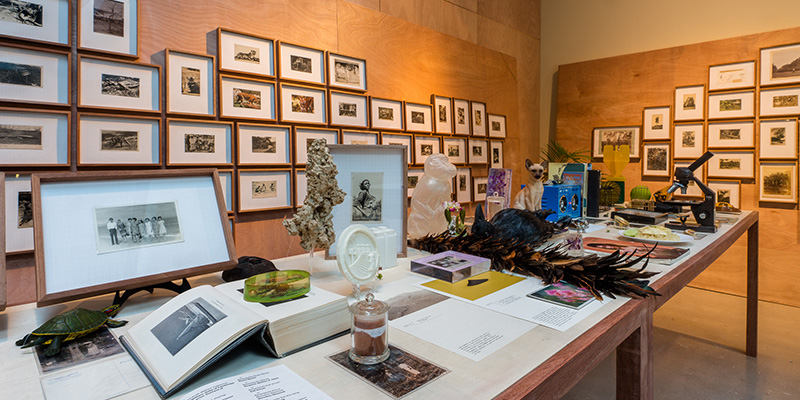
Natural History of an Island (Objects on Tables)
Mixed media, dimensions variable
2011-ongoing
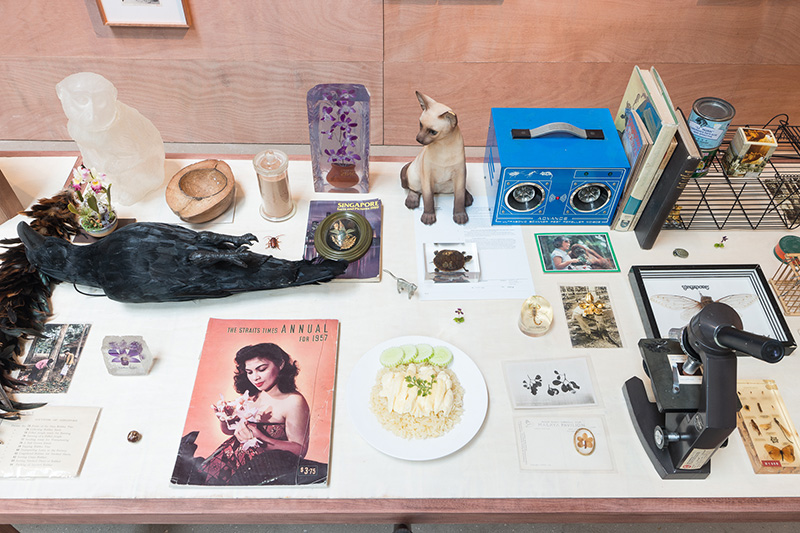
A secret need for your existence
Mixed media, 2012
Stray cats in Singapore have their left ears clipped to show that they have been spayed so that they will not be sterilised twice.
Mask and Stone Hand, Singapore, 1998
Several such masks and artefacts were uncovered by The Coast Exploration Society in the late 1970s. During that time, Singapore began a major phase of land reclamation around the Eastern Coast. In the early days, the reclaimed land took the form of vast, desert-like sand dunes which were rarely visited by the public. The Society began organising tours and activities such as picnics, sand-sculpture competitions and fishing trips for the public. Due to the Society’s efforts, these sand dunes became very popular weekend destinations with Singapore families. One activity that became especially popular was treasure-hunting in the sand.
Fulgurite, 1998
Singapore experiences lightning 186 times a year. Fulgurites are natural hollow glass tubes often formed during lightning strikes, in quartzose sand, silica or soil. When lightning hits sand or silica with a temperature of at least 1,800°C, it melts the sand and fuses mineral grains together; the fulgurite glass tube is the cooled product.
The Coast Exploration Society regularly found small chunks of hardened sediment in the sand dunes. In the ICZ’s collection is the largest fulgurite found at the Tanah Merah sand dune.
Risis Flora Souvenirs
In the 1970s, as part of the Singapore government’s plan to produce a unique souvenir, RISIS (or SISIR, Singapore Institute of Standards and Industrial Research spelt in reverse) was formed to produce and market gold-plated orchids. Orchids are native to Singapore and also the national flower.
Fragment of the Singapore Stone
The Singapore Stone is a fragment of a large sandstone slab which originally stood at the mouth of the Singapore River. Dating back to the 13th century, the slab bore an undeciphered inscription believed to hold the secrets to Singapore’s history. However, the slab was blown up in 1843 to make way for a fort. The largest fragment left is the SIngapore Stone, now housed in the National Museum of Singapore. The other two recorded pieces were sent to The Royal Asiatic Society in Culcatta for analysis in 1848 but are now presumably lost.
In the last decade, small stones, allegedly part of the larger slab, started to surface on Ebay and the black market.
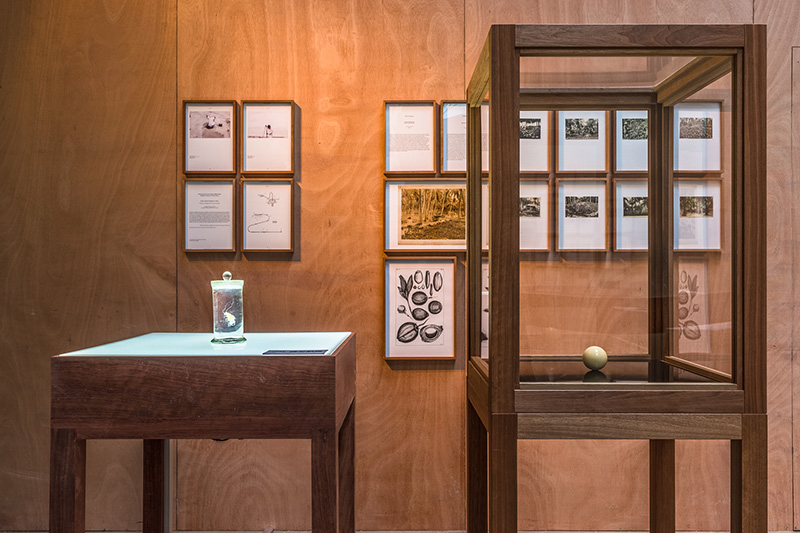
Coconut Pearl
Occurring in one out a million coconuts, the coconut pearl is the rarest botanical gems in the world. In the early 1900s, there were 54 farms in Singapore dedicated to harvesting coconut pearls.
The coconut pearl was first described in 1741 by German-born botanist Georg Eberhard Rumpf in his book Herbarium Amboinense. The secrets of harvesting the pearls are closely guarded among plantation owners. A theory remains that the lightning from the frequent thunderstorms in Singapore help encourage the growth of the pearls.

Kings
White cockroaches are a rare form of melanism in cockroaches that can occur as a result of environmental pressure. Entomologists theorised that the cockroaches living in sand dunes had adapted to life in the sand by turning white as camouflage. There are two known cases of white cockroaches in the world: in the Tottori sand dunes of Japan in Singapore in the 70s, when intense land reclamation began.
In Singapore, lighter-coloured cockroaches could blend in with the sand and were less likely to be eaten by birds. On display is the first live specimen ever collected. There are also reports of white crows in the reclaimed land in Singapore.
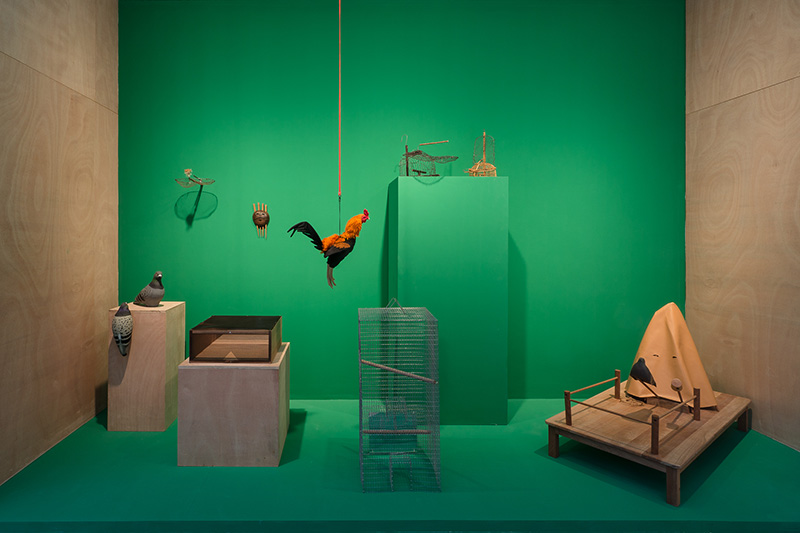

A history of birds
Pigeon Decoy Hut from The Book, Malay Magic, 1890s
This is a set-up used by early Malay hunters to trap forest pigeons for food, as detailed in Walter William Skeat’s Malay Magic (1900). The trap comprises a conical hut, in which the hunter crouches. A trained pigeon perches on one of the horizontal rods and issues a challenge call to other pigeons. When a wild pigeon responds to the call and lands near the trap, the hunter extends a hooped rod, snares the pigeon by its neck or feet, and drags it into the hut.
Songbird Traps, Matah Puteh, 1970s
Songbird keeping was a popular activity in Singapore in the 70s. These traps were used to catch the matah puteh, or Oriental white-eye. Usually placed high up in a tree, the traps use a captive young female in its holding area to attract a wild male bird.
Decoy Cock, Thailand
Cockfighting is a bloodsport that is part of a 700-year-old tradition in Thailand. A decoy cock, suspended in the middle of the ring, is used to train the aggressiveness and stamina of the roosters. The rooster attacks the decoy as the latter swings about in circles from the string.
The longer a bird can fight in a ring, the stronger and more valuable it would be. A prized Thai rooster that was undefeated for 21 rounds was sold for US$90,000 in 2015.
Bird Tower with Mirrors, EM1030, Singapore
Birds enter a trap more easily when there is already a bird inside. The Bird Tower, which is designed to catch 30 to 40 birds at one go, uses a large mirror to trick birds into believing that there are already birds in the cage.
Mirror Trap Parakeet, Japan
This mirror trap traps runaway parakeets and pet birds. Parakeets in particular are attracted to their own reflection and would spend a long time observing their own reflection.
Thistle Goldfinch Spring Trap, Italy
Usually placed on a tree, this trap uses the thistle as a bait.
Soar No More Feral Pigeon Decoy
These decoy pigeons attract wild feral pigeons to an area to nest. Once the pigeons lay their eggs, they are quickly destroyed to prevent population growth. The fake pigeons are also used as hunting decoys.
Enta Birdking Spray Applicant
The most effective bird-aversion agent, BIRDKING EM-149K is a concentrated formula that can be sprayed to a height of over 90 metres. The chemicals in the formula irritates the pain receptors associated with taste and smell in birds.
Enta Bird Spring Remote Trap with Observation Hide
Conventional spring traps and cages for pigeons and mynahs often fail to work after a few months, because the birds learn. This remote-controlled spring trap was developed to give the trapper the ultimate element of surprise. For best results, the trapper should be in the tent for at least two hours before activating the trap.
The Blue Prince
The Blue Prince was a champion pigeon racer which covered hundreds of miles at jaw-dropping speeds. In 2011, he was auctioned off at Pigeon Paradise (PiPa), Belgium’s premier pigeon auction house, for US$200,000. The Blue Prince was bred and later produced the next generation of champion racers for its owners.
Chicken Rice Archaeology
In 2012, the ICZ conducted an experiment involving major chicken rice stalls in Singapore. To determine the uniformity in size of the chickens supplied to these eateries, the Institute salvaged bones from meals to reconstruct whole skeletons. True enough, even different bones were taken from different restaurants, the ICZ managed to construct a fully connected, stable skeleton.
Passenger Pigeon Trap & The New Rustic House (1789)
Published in France in 1798, The New Rustic House is a compendium of rural economy. Of the 431 traps described in the book, 381 traps can no longer be used as the target birds have become extinct. The passenger pigeon went extinct in 1914 due to overhunting.
Enta Solar Bird Chaser & Enta Bird Chaser
As it rotates in the sun, this bird deterrent flashes dramatic holographic images that frighten birds.
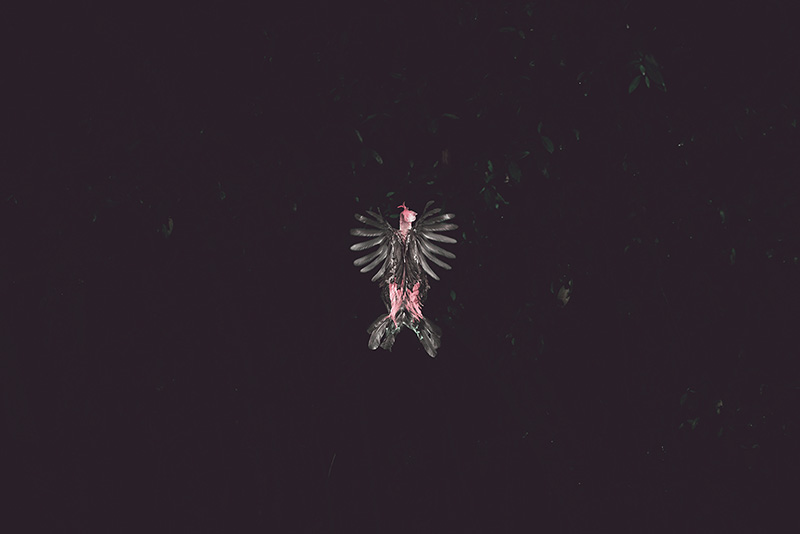
The Rooster Will Crow Three Times
All domesticated chickens trace their ancestry back to the red junglefowl, which is native to Singapore, and was first domesticated about 5,000 years ago.
Due to urbanisation, the red junglefowl was locally extinct as of 1927, but was re-discovered in 1985 on Pulau Ubin. Since 1993, starting from the east side, they have spread back onto the mainland. They are now a common sight in residential neighbourhoods like Yishun and Bukit Gombak.
The resurgence of jungle fowl today is related to the selective re-greening of the city, an attempt to soften the urban landscape with greenery. These photographs were taken in Sin Ming Avenue, and the family in these photos was put down earlier this year due to complaints by nearby residents.
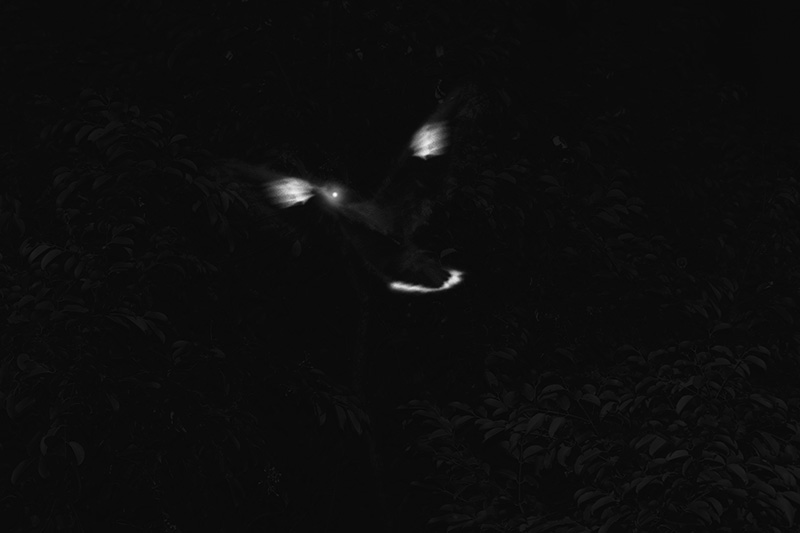
Singapore Javan Mynah Society
Sundown at Orchard Road in Singapore is marked by a massive flurry of mynahs coming to roost. Over the years, business-owners have taken measures — including deploying a hawk to prey on the birds — against the mynah population, mostly in vain. In the 1980s, a group of local nature lovers formed the Singapore Javan Mynah Society, hoping to turn the roosting event into a tourist attraction. The society led tours out to Orchard Road to witness the roosting, which they marketed as “a spectacular natural phenomenon in the heart of the city”. They also sold merchandise such T-shirts, toys and postcards.
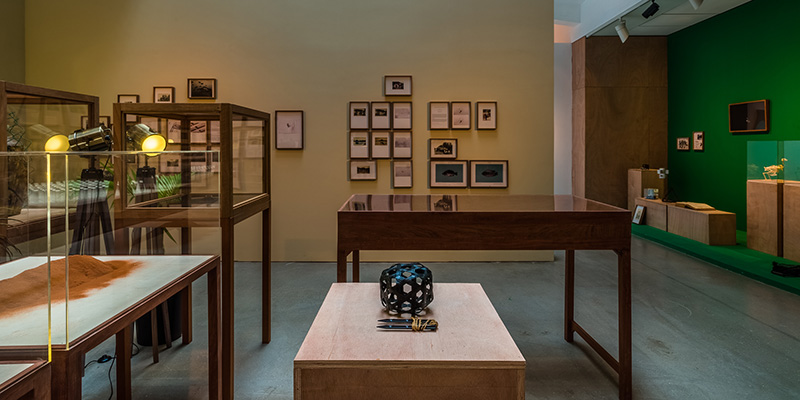 Experiments
Experiments
The Institute conducts experiments that explore the everyday interactions between human beings and the natural world, seeking to present natural phenomena and scientific ideas in new and unusual ways.
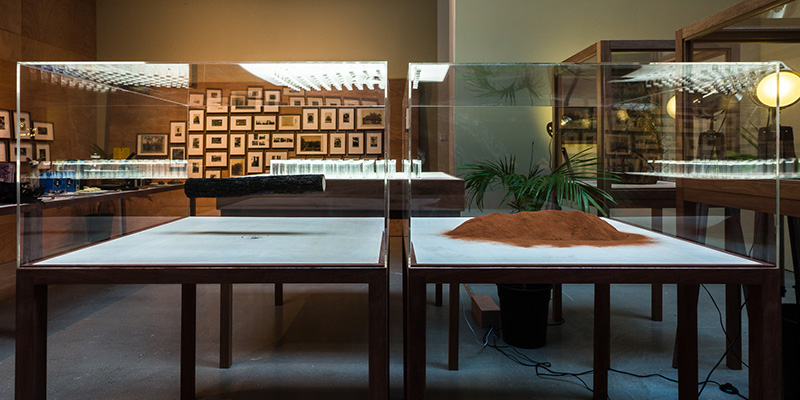
How To Make A Tree Disappear As Nature Intended I & II (2015) (Previously shown at The Substation)
Sawdust, Log, Powderpost beetles
The Institute salvaged a branch of a tree that was felled for development. The inside of this branch was slowly being eaten by the larvae of powderpost beetles, which spend months or years inside reducing the wood to fine powder. Their presence is only apparent when they emerge as adults, leaving behind pinhole-sized openings, often called "shot holes". If conditions are right, female beetles may lay their eggs and re-infest the wood, continuing the cycle for generations, and eventually reducing the wood to a pile of dust.
The Institute conducted an experiment to measure the dust-making labour of the beetle in man-hours. It takes a cluster of larvae about a year to reduce a tree branch to dust. With continuous, mechanical action using sandpaper, it takes a human being 580 hours.
On display here are two piles of tree dust: a colony of powderpost beetles feeding on a branch, and an accompanying pile of man-made tree dust.

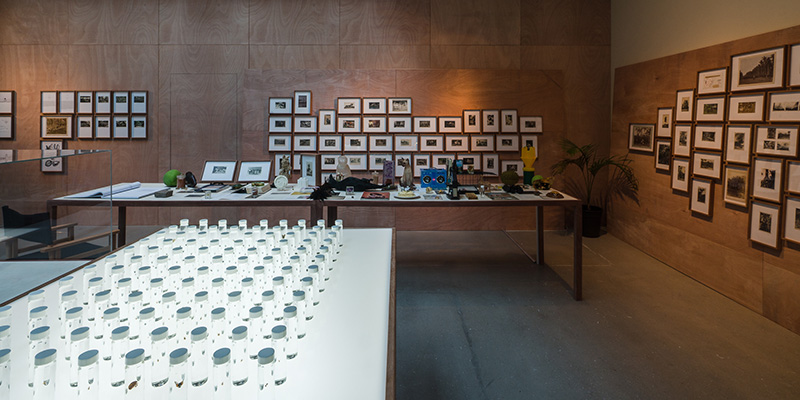
All The Insects In The House
Over a single day, researchers gathered insect carcasses from windows, insect traps, house corners and other crevices within a single home. These carcasses reveal the wide variety of insect life that can be found in human habitats. In a typical home, hundreds of insects co-exist with human beings, though they go largely unnoticed. There are over 100 varieties represented here.
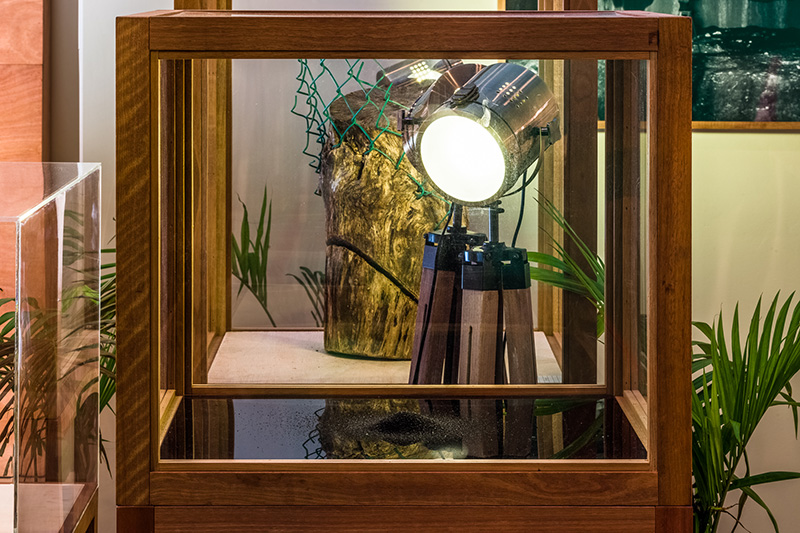 Moondust
Moondust
This is material gathered from a single domestic ceiling lamp. It contains the incinerated remains of flying insects. It is unclear why insects are so attracted to electric lights, but scientists speculate that insects mistake these lights for the moon. Insects are so drawn to the light that they fly around the light until they die of exhaustion, and their bodies drop into the lamp shades, where they are eventually burnt by the heat of the light. As many as 137 species of insect have been collected from a single lamp.
Monkey Trap circa 1940s
Rattan, holder, string
An old Malayan Monkey Trap used to capture monkeys to train to collect fruits. A fruit is covered with ‘birdlime’, a sticky latex, that prevents the hand of the monkey from pulling out of the trap once it grabs the fruit.
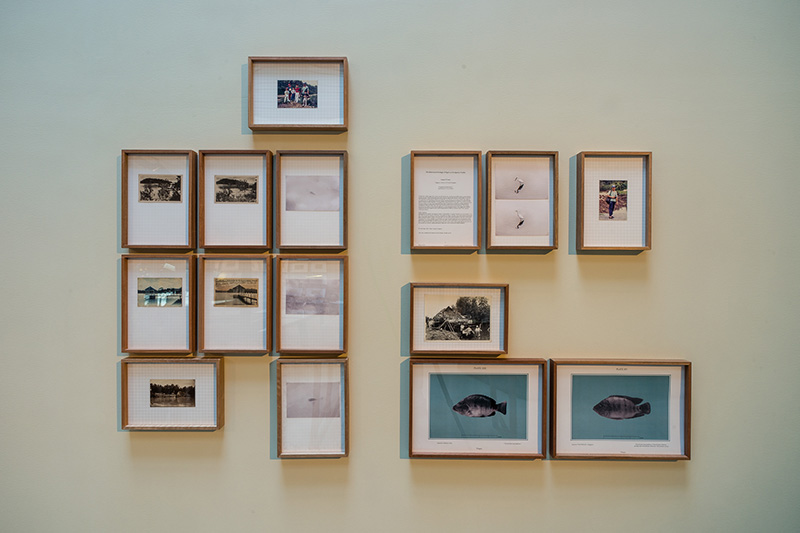

Bats, Mangroves, Durians, Reservoirs, Tilapias & Floods: The Francis Leow Archives (For more information for this work, click here)
This section assembles some of the papers, photographs and objects of Francis Leow (1935-2005), acquired by the Institute after his death. Unlike many amateur naturalists, Leow was an avid researcher who spent much of his life meticulously documenting Singapore’s biodiversity and ecology. He developed volumes of field research and subsequently presented his findings in some 100 papers and proposals. Professionally, Leow was personal assistant to Humphrey Burkill, director of the Singapore Botanical Gardens from 1957 to1969.
Leow was not a trained biologist, but wrote numerous scientific papers over the course of his life. He was never taken as a serious researcher, and his papers were disregarded as amateur jottings, mostly because they made use of social histories and personal anecdotes to make far-fetched claims. Much of Leow’s work revolved around Singapore’s waterways because of his childhood in stilt houses of what was once the Pandan mangrove, now a freshwater reservoir. He is most known as the man who saved Singapore’s durians with his work on bats. He secretly created hundreds of habitats for bats of Singapore under flyovers.
 Francis Leow creating artificial habitats for bats underneath flyovers, circa 1980s.
Francis Leow creating artificial habitats for bats underneath flyovers, circa 1980s.
Highlights of the Francis Leow Archives: Selected Summaries
1. Bats, Mangroves and Durians
In 1967, Leow wrote a paper, Bats, Mangroves and Durians. Although it was never published, the paper was one of the earliest accounts of a pollinator relationship between bats and durian trees.
The research came about because Leow, an avid forager of wild durians, wondered why harvests were getting worse each year. Chancing upon Walter William Skeat’s Malay Magic: An Introduction to the Folklore and Popular Religion of the Malay Peninsula (1900), he read about the spiritual connection between durian trees and their “demonic, blood-sucking guardians”, bats.
Leow writes: “We are today inclined to dismiss the ancient folk knowledge of this island’s earliest inhabitants, but that is the greatest arrogance. What we understand as ‘pollination’, the old Malays of the island described as the ‘custodianship’ of bats.”
The paper goes on to argue that the decline of durian numbers must be connected to declining bat populations, which had been affected by recent reclamation activities in the Pandan area.
These were only theories, and Leow could not prove these connections. It was only after his death that scientists confirmed that the only pollinator of durian trees is the Cave Nectar Bat, a native species endangered by the loss of green cover and mangrove areas which are a major source of food and shelter.
2. Flyovers as Day Roosts for Bats
In 1987, Leow wrote a paper, Flyovers as Day Roosts for Bats, proposing to relevant government agencies to mitigate the displacement of bat populations. He suggested that the underside of highways be “retextured” so that bats can hang on to the craggy surfaces with their claws. The idea was never adopted.
In secret, Leow worked on a few flyover tunnels himself to create more urban “caves” near forested areas, which local authorities only discovered after his death.
3. Tilapias
One of Leow’s lifelong obsessions was the common tilapia. During the Japanese Occupation of Singapore, the Japanese army brought breeding stocks of Oreochromis mossambicus from Java to Singapore as a source of protein. This explains why the local names for tilapia are Japanese Fish and Java Fish. But the true origins of the fish lie in East Africa. Tilapia were in fact brought to Asia by traders.
Leow kept detailed records of the tilapia he caught from canals and reservoirs. Over the years, he began to notice changes to their appearance. He realised that the original variety of tilapia, the ones brought in by the Japanese, was slowly declining, replaced by a hybrid of at least three different species from the same family.
In his journals, Leow writes that he discovered that they were breeding with farmed red tilapia, a restaurant delicacy. Fish farmers told Leow that during periods of flooding after heavy rain, it was common for the farmed fish to escape into local canals.
4. Where Can All The Rain Go Now?
After his retirement in 1987, Leow turned his energy to community activities and popular science communication. He led nature tours for children and families, and was eventually invited to give talks on ecology and conservation at libraries and community centres.
A folder in his personal computer, titled Where Can All The Rain Go Now?, contains texts, photographs, research jottings and lecture materials from his community talks. We believe this was preparatory material for a book-length project that was left incomplete. His thesis is that flooding in Singapore is caused by the destruction of mangrove environments to create freshwater reservoirs, a process which “left the island senile, unable to drain itself”.
Selections from the Photographic Collection of Francis Leow
Francis Leow and H. Burkill, Expedition, Pandan Mangroves, 1967
Francis Leow, Pandan Mangroves, 1967
Francis Leow, Pandan Mangroves, 1967
Francis with Durian, c.1941
Francis's Colleague, Charles, on Durian Tree, 1967
Flying Foxes on Singapore Island, 1893
Studies of Bats on Trees, Possibly Remote Triggered, 1969-1980
Singapore Boy with Flying Fox (numerous), circa 1900
Singapore Boy with Possibly Last Flying Fox on Singapore Island, 1938
Man with Small Bat, 1977
Small Bat Studies Underneath Flyover (Various), 1970-1998
Japanese Album Belonging to Officer who Brought Tilapia from Indonesia to Singapore, 1943
Tilapia Study Chart, 1987
Francis Leow, Pulau Ubin, 1989
Studies of High Tide and Low Tide, Singapore, 1910s
First Recorded Flood on Singapore Island, near Singapore River, Possibly 1890s.
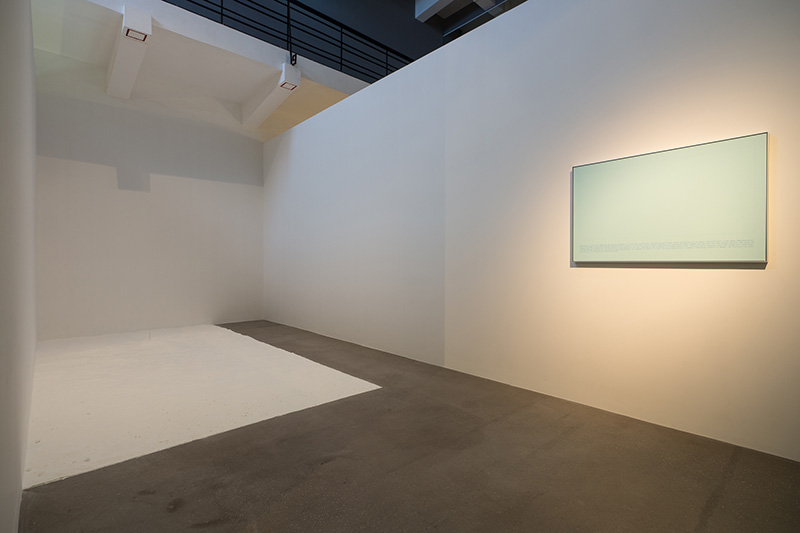
Eskimo Wolf Trap often quoted in Sermons, 2013 (For more information of this work, click here.)
Installation of diasec, eskimo knife, polyurethane, 200 kg of sodium bicarbonate
"Eventually, a wolf will approach the knife and begin to cautiously sniff and lick the frozen blood. After believing it is safe, the wolf will lick more aggressively. Soon, the blade of the knife becomes exposed and it begins to nick the wolf’s tongue. Because its tongue has been numbed by the cold, the wolf is unaware that he is being cut, and the blood it now tastes is its own. Excited at the prospect of fresh, warm blood, the wolf will hungrily lick the blade all the more. In a short time, the wolf will grow dizzy and disoriented. In a matter of hours, it will die from blood loss, literally drinking itself to death. As horrible as this picture is, it illustrates an important truth."
Copyright 2018, Institute of Critical Zoologists